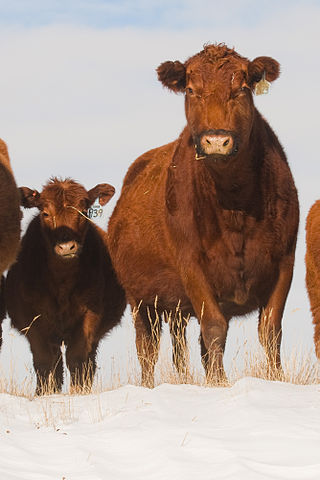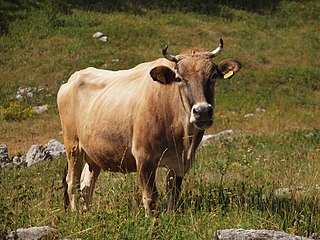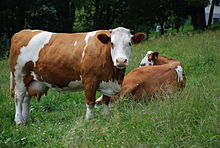
The Charolais or Charolaise is a French breed of taurine beef cattle. It originates in, and is named for, the Charolais area surrounding Charolles, in the Saône-et-Loire department, in the Bourgogne-Franche-Comté region of eastern France.

The Simmental or Swiss Fleckvieh is a Swiss breed of dual-purpose cattle. It is named after the Simmental – the valley of the Simme river – in the Bernese Oberland, in the canton of Bern in Switzerland. It is reddish in colour with white markings, and is raised for both milk and meat.

The Red Angus is an international breed of beef cattle characterised by a reddish-brown coat colour. It derives from the Scottish Aberdeen Angus population and, apart from the coat colour, is identical to it. Red Angus are registered separately from black Angus cattle in Australia, Canada, and the United States.

The Dairy Shorthorn is a British breed of dairy cattle. It derives from the Shorthorn cattle of Tees-side, in the North Riding of Yorkshire and in Northumbria in north-eastern England. The Shorthorn was for this reason at first known as the Durham or Teeswater.

The South Devon is a British breed of large beef cattle. It originated in the counties of Devon and Cornwall in south-west England, and is mentioned from the eighteenth century. It was a dual-purpose breed, kept both for its milk and for beef. Since 1972 selection has been for beef only.

The Kankrej is an Indian breed of zebuine cattle. It originates from the arid region of the Rann of Kutch in the state of Gujarat, and in neighbouring Rajasthan. Under the name Kankaraj, it is also present in Tharparkar District, in Sindh, Pakistan. It is also known by the names Bannai, Nagar, Talabda, Vaghiyar, Wagad, Waged, Vadhiyar, Wadhiar, Wadhir and Wadial. It is a dual-purpose breed, used both for draught work and for milk production.

Red Sindhi cattle are the most popular of all Zebu dairy breeds. The breed originated in the Sindh province of Pakistan, they are widely kept for milk production across Pakistan, India, Bangladesh, Sri Lanka, and other countries. Their milk production is about 12 to 15 kg per day They have been used for crossbreeding with temperate (European) origin dairy breeds in many countries to combine their tropical adaptations with the higher milk production found in temperate regions. It has been crossed with Jerseys in many places, including India, the United States, Australia, Sri Lanka, etc.

The Maine-Anjou is a French breed of domestic cattle, raised mainly in the Pays de la Loire region in north-western France. It was created in the nineteenth century in the historic province of Maine by cross-breeding the local Mancelle dairy cattle with Durham stock from Britain, and was at first called the Durham-Mancelle. In France it has been known since 2004 as the Rouge des Prés, but the Maine-Anjou name continues to be used elsewhere. It was formerly a dual-purpose animal, raised both for meat and for milk, but is now principally a beef breed.

The Pinzgauer is a breed of domestic cattle from the Pinzgau region of the federal state of Salzburg in Austria. It has distinctive colouring, with chestnut-brown sides and white back and underside. It was in the past a triple-purpose breed, raised for meat, milk and draught use. There is a naturally polled sub-type, the Jochberg Hummel. In 2007 the breed was not considered by the FAO to be at risk.

The Buša or Busha is a breed or group of breeds of small short-horned cattle distributed in south-eastern Europe, principally in Albania and the countries of the former Yugoslavia – Bosnia and Herzegovina, Croatia, Kosovo, Macedonia, Montenegro and Serbia. Related breeds include the Gurgucke, Lekbibaj and Prespa of Albania, the Gacko of Bosnia and Herzegovina, the Greek Shorthorn, the Metohija Red of Kosovo and the Rhodope Shorthorn of Bulgaria.

The Japanese Black is a breed of Japanese beef cattle. It is one of six native Japanese cattle breeds, and one of the four Japanese breeds known as wagyū, the others being the Japanese Brown, the Japanese Polled and the Japanese Shorthorn. All wagyū cattle derive from cross-breeding in the early twentieth century of native Japanese cattle with imported stock, mostly from Europe. In the case of the Japanese Black, the foreign influence was from European breeds including Braunvieh, Shorthorn, Devon, Simmental, Ayrshire and Holstein.

The Japanese Brown is a breed of small Japanese beef cattle. It is one of six native Japanese cattle breeds, and one of the four Japanese breeds known as wagyū, the others being the Japanese Black, the Japanese Polled and the Japanese Shorthorn. All wagyū cattle derive from cross-breeding in the early twentieth century of native Japanese cattle with imported stock, mostly from Europe. In the case of the Japanese Brown, the principal foreign influence was from the Korean Hanwoo and Swiss Simmental breeds.
The Bestuzhev is a dual-purpose cattle breed from Uzbekistan created in the Soviet era by crossing the native Zebu cattle with Dutch Brown Swiss and Simmental bulls.

The Armoricaine or Armorican is an endangered French breed of domestic cattle. It originated in Brittany in the nineteenth century. It has a red coat with white markings, and has short horns.

The Parthenaise is a French cattle breed. It is named for the town of Parthenay in the département of Deux-Sèvres, in the Nouvelle-Aquitaine region of western France. It was formerly a triple-purpose breed, raised for milk, meat and draught work, but is now raised mainly for beef.

The Lincoln Red is a British breed of red-coated beef cattle. It originates in, and is named for, the county of Lincolnshire in the eastern Midlands of England. It was selectively bred in the late eighteenth and early nineteenth centuries by crossing large local draught cattle of the region with Teeswater Shorthorns of medium size. It was at first known as the Lincolnshire Red Shorthorn, and was a dual-purpose breed, reared both for milk and for beef. The polling gene was introduced in the early twentieth century, and the cattle are now usually polled; the word 'shorthorn' was dropped from the breed name in 1960. In the twenty-first century it is reared for beef.

The Bianca Modenese or Modenese is a breed of dual-purpose cattle from the Po Valley, in the Emilia Romagna and Lombardy regions of northern Italy. It is raised for beef and milk production, but in the past was a triple-purpose breed, used also as a draught animal. The name derives from that of the province of Modena, where it is thought to have originated. In the nineteenth century it was concentrated in the area of Carpi, and was sometimes known as the Carpigiana. It was later distributed through much of the Po Valley, and thus also known as the Bianca della Val Padana.

The Valdostana Pezzata Rossa is an Italian breed of cattle from Valle d'Aosta region in north-western Italy. It is red-pied, usually with white legs, stomach and face. It is one of three regional breeds in the area, the others being the Valdostana Castana and the Valdostana Pezzata Nera. Like them, it derives from inter-breeding of various local breeds and types of cattle. The most important of these were Swiss Simmental cattle, which came into the Valle d'Aosta over the Great St. Bernard Pass. The Valdostana Pezzata Rossa is a dual-purpose breed, raised mainly for milk, but also for meat. Management is normally transhumant: the cattle are stabled only in winter, and spend the summer months on the mountain pastures of the Alps.
The Swiss Holstein is the Swiss variant of the international Holstein-Friesian breed of dairy cattle. It results from systematic cross-breeding, through artificial insemination between 1966 and 1973, of the traditional dual-purpose black-pied Fribourgeoise from the Canton of Fribourg in western Switzerland with Canadian Holstein stock.



















